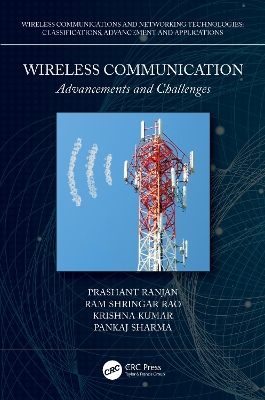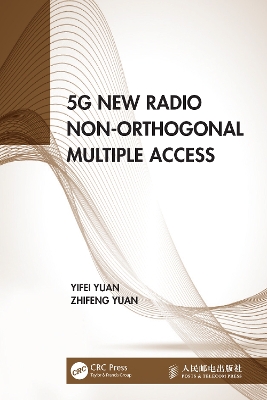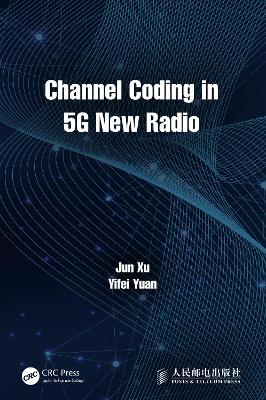Wireless Communication
 portes grátis
portes grátis
Wireless Communication
Advancements and Challenges
Kumar, Krishna; Sharma, Pankaj; Ranjan, Prashant; Rao, Ram Shringar
Taylor & Francis Ltd
10/2024
178
Mole
9781032020655
Pré-lançamento - envio 15 a 20 dias após a sua edição
Descrição não disponível.
Chapter 1: Internet of Things (IoT)
1.1 Introduction
1.2 The Continuing Evolution of IoT
1.3 The Key Drivers of Rapid Adoption of IoT
1.4 How Does IoT Work
1.5 Importance of IoT
1.6 Benefits of IoT to Businesses
1.7 Potential of IoT
1.8 Architecture of IoT
1.9 IoT Standards and Frameworks
1.10 Enabling Technologies for IoT
1.11 Future Technological Developments for IoT
1.12 Future Application Areas
1.13 Pros and Cons of IoT
1.14 IoT Security and Privacy Issues
1.15 Tips to Help Secure User's Smart Home and IoT Devices
1.16 Future Challenges for IoT
1.17 Conclusion
Chapter 2: Application of IoT for Pandemic Detection
2.1 Introduction
2.2 Emergency Care System
2.3 Previous Works
2.4 Application of IoT and Smart Technology for Pandemic Detection
2.5 Conclusion
Chapter 3: TV White Space (TVWS) Technology
3.1 Introduction
3.2 Underutilized Spectrum
3.3 Evolution of TVWS
3.4 Standardization of TVWS
3.5 Regulations on TVWS
3.6 The Limitations of TVWS Regulation
3.7 Commercial Pilots and Trials of TVWS
3.8 Applications and Use Cases of TVWS
3.9 SWOT Analysis
3.10 Conclusion
Chapter 4: Health Monitoring and Pandemic Detection using IoT and Wireless Communication Technologies
4.1 Introduction
4.2 Previous Works
4.3 Proposed Model
4.4 Conclusions
Chapter 5: V2V: The Future of VANET's Communications
5.1 Vehicular Ad-hoc Network (VANET)
5.2 Communication Domains of VANET
5.3 VANET's Characteristics
5.4 VANET's Challenges
5.5 VANET Applications
5.6 Vehicle-to-Vehicle Communication (V2V)
5.7 Working of V2V Communication
5.8 Benefits of V2V Communications
5.9 V2V Tracking and Reporting
5.10 V2V Security in Communication
5.11 Future of V2V Communication
5.12 Conclusion
Chapter 6: IoT Based Flood Control and Disaster Management System for Dam and Barrage
6.1 Introduction
6.2 Investigations on Dam and Barrage Monitoring
6.3 Circuit Configuration for Monitoring and Control of Dam/Barrage
6.4 Conclusions
Chapter 7: An Overview of Smart Antenna Technology for Wireless Communication
7.1 Introduction
7.2 Smart Antenna
7.3 Advantages and Disadvantages of Smart Antennas
7.4 Types of Smart Antenna System
7.5 Difference Between Switched Beam System and Digitally Adaptive Beamforming System
7.6 Applications of Smart Antenna System
7.7 Conclusion
Chapter 8: UAV: Communication and Object Detection System
8.1 Introduction
8.2 Application Scenarios of UAVs
8.3 Major Issues and Challenges of UAVs
8.4. UAV Communication
8.5 Conclusion
Chapter 9: Smart Pole System: A Connectivity to City Services
9.1 Introduction
9.2 Limitations of Conventional Pole System
9.3 Benefits of Smart Pole System
9.4 Smart Pole System Design
9.5 Conclusion
1.1 Introduction
1.2 The Continuing Evolution of IoT
1.3 The Key Drivers of Rapid Adoption of IoT
1.4 How Does IoT Work
1.5 Importance of IoT
1.6 Benefits of IoT to Businesses
1.7 Potential of IoT
1.8 Architecture of IoT
1.9 IoT Standards and Frameworks
1.10 Enabling Technologies for IoT
1.11 Future Technological Developments for IoT
1.12 Future Application Areas
1.13 Pros and Cons of IoT
1.14 IoT Security and Privacy Issues
1.15 Tips to Help Secure User's Smart Home and IoT Devices
1.16 Future Challenges for IoT
1.17 Conclusion
Chapter 2: Application of IoT for Pandemic Detection
2.1 Introduction
2.2 Emergency Care System
2.3 Previous Works
2.4 Application of IoT and Smart Technology for Pandemic Detection
2.5 Conclusion
Chapter 3: TV White Space (TVWS) Technology
3.1 Introduction
3.2 Underutilized Spectrum
3.3 Evolution of TVWS
3.4 Standardization of TVWS
3.5 Regulations on TVWS
3.6 The Limitations of TVWS Regulation
3.7 Commercial Pilots and Trials of TVWS
3.8 Applications and Use Cases of TVWS
3.9 SWOT Analysis
3.10 Conclusion
Chapter 4: Health Monitoring and Pandemic Detection using IoT and Wireless Communication Technologies
4.1 Introduction
4.2 Previous Works
4.3 Proposed Model
4.4 Conclusions
Chapter 5: V2V: The Future of VANET's Communications
5.1 Vehicular Ad-hoc Network (VANET)
5.2 Communication Domains of VANET
5.3 VANET's Characteristics
5.4 VANET's Challenges
5.5 VANET Applications
5.6 Vehicle-to-Vehicle Communication (V2V)
5.7 Working of V2V Communication
5.8 Benefits of V2V Communications
5.9 V2V Tracking and Reporting
5.10 V2V Security in Communication
5.11 Future of V2V Communication
5.12 Conclusion
Chapter 6: IoT Based Flood Control and Disaster Management System for Dam and Barrage
6.1 Introduction
6.2 Investigations on Dam and Barrage Monitoring
6.3 Circuit Configuration for Monitoring and Control of Dam/Barrage
6.4 Conclusions
Chapter 7: An Overview of Smart Antenna Technology for Wireless Communication
7.1 Introduction
7.2 Smart Antenna
7.3 Advantages and Disadvantages of Smart Antennas
7.4 Types of Smart Antenna System
7.5 Difference Between Switched Beam System and Digitally Adaptive Beamforming System
7.6 Applications of Smart Antenna System
7.7 Conclusion
Chapter 8: UAV: Communication and Object Detection System
8.1 Introduction
8.2 Application Scenarios of UAVs
8.3 Major Issues and Challenges of UAVs
8.4. UAV Communication
8.5 Conclusion
Chapter 9: Smart Pole System: A Connectivity to City Services
9.1 Introduction
9.2 Limitations of Conventional Pole System
9.3 Benefits of Smart Pole System
9.4 Smart Pole System Design
9.5 Conclusion
Este título pertence ao(s) assunto(s) indicados(s). Para ver outros títulos clique no assunto desejado.
4G, 5G, 6G cellulear technologies;Long-range wireless communication;Cognitive Radio Networks;Smart Antenna Technology;Vehicle-to-Everything (V2X) wireless technology;TV White Space Technology;IoT Sensor;Smart Cities;IoT Device;V2V Communication;Smart Antenna;Smart Antenna System;Radar;IoT Architecture;PIR Sensor;UAV Image;Chronic;Smart Pole;UWB Antenna;IoT Application;UAV Market;White Spaces;VANET;IoT Network;GLDB;EV;IoT System;V2X Communication;Small UAVs
Chapter 1: Internet of Things (IoT)
1.1 Introduction
1.2 The Continuing Evolution of IoT
1.3 The Key Drivers of Rapid Adoption of IoT
1.4 How Does IoT Work
1.5 Importance of IoT
1.6 Benefits of IoT to Businesses
1.7 Potential of IoT
1.8 Architecture of IoT
1.9 IoT Standards and Frameworks
1.10 Enabling Technologies for IoT
1.11 Future Technological Developments for IoT
1.12 Future Application Areas
1.13 Pros and Cons of IoT
1.14 IoT Security and Privacy Issues
1.15 Tips to Help Secure User's Smart Home and IoT Devices
1.16 Future Challenges for IoT
1.17 Conclusion
Chapter 2: Application of IoT for Pandemic Detection
2.1 Introduction
2.2 Emergency Care System
2.3 Previous Works
2.4 Application of IoT and Smart Technology for Pandemic Detection
2.5 Conclusion
Chapter 3: TV White Space (TVWS) Technology
3.1 Introduction
3.2 Underutilized Spectrum
3.3 Evolution of TVWS
3.4 Standardization of TVWS
3.5 Regulations on TVWS
3.6 The Limitations of TVWS Regulation
3.7 Commercial Pilots and Trials of TVWS
3.8 Applications and Use Cases of TVWS
3.9 SWOT Analysis
3.10 Conclusion
Chapter 4: Health Monitoring and Pandemic Detection using IoT and Wireless Communication Technologies
4.1 Introduction
4.2 Previous Works
4.3 Proposed Model
4.4 Conclusions
Chapter 5: V2V: The Future of VANET's Communications
5.1 Vehicular Ad-hoc Network (VANET)
5.2 Communication Domains of VANET
5.3 VANET's Characteristics
5.4 VANET's Challenges
5.5 VANET Applications
5.6 Vehicle-to-Vehicle Communication (V2V)
5.7 Working of V2V Communication
5.8 Benefits of V2V Communications
5.9 V2V Tracking and Reporting
5.10 V2V Security in Communication
5.11 Future of V2V Communication
5.12 Conclusion
Chapter 6: IoT Based Flood Control and Disaster Management System for Dam and Barrage
6.1 Introduction
6.2 Investigations on Dam and Barrage Monitoring
6.3 Circuit Configuration for Monitoring and Control of Dam/Barrage
6.4 Conclusions
Chapter 7: An Overview of Smart Antenna Technology for Wireless Communication
7.1 Introduction
7.2 Smart Antenna
7.3 Advantages and Disadvantages of Smart Antennas
7.4 Types of Smart Antenna System
7.5 Difference Between Switched Beam System and Digitally Adaptive Beamforming System
7.6 Applications of Smart Antenna System
7.7 Conclusion
Chapter 8: UAV: Communication and Object Detection System
8.1 Introduction
8.2 Application Scenarios of UAVs
8.3 Major Issues and Challenges of UAVs
8.4. UAV Communication
8.5 Conclusion
Chapter 9: Smart Pole System: A Connectivity to City Services
9.1 Introduction
9.2 Limitations of Conventional Pole System
9.3 Benefits of Smart Pole System
9.4 Smart Pole System Design
9.5 Conclusion
1.1 Introduction
1.2 The Continuing Evolution of IoT
1.3 The Key Drivers of Rapid Adoption of IoT
1.4 How Does IoT Work
1.5 Importance of IoT
1.6 Benefits of IoT to Businesses
1.7 Potential of IoT
1.8 Architecture of IoT
1.9 IoT Standards and Frameworks
1.10 Enabling Technologies for IoT
1.11 Future Technological Developments for IoT
1.12 Future Application Areas
1.13 Pros and Cons of IoT
1.14 IoT Security and Privacy Issues
1.15 Tips to Help Secure User's Smart Home and IoT Devices
1.16 Future Challenges for IoT
1.17 Conclusion
Chapter 2: Application of IoT for Pandemic Detection
2.1 Introduction
2.2 Emergency Care System
2.3 Previous Works
2.4 Application of IoT and Smart Technology for Pandemic Detection
2.5 Conclusion
Chapter 3: TV White Space (TVWS) Technology
3.1 Introduction
3.2 Underutilized Spectrum
3.3 Evolution of TVWS
3.4 Standardization of TVWS
3.5 Regulations on TVWS
3.6 The Limitations of TVWS Regulation
3.7 Commercial Pilots and Trials of TVWS
3.8 Applications and Use Cases of TVWS
3.9 SWOT Analysis
3.10 Conclusion
Chapter 4: Health Monitoring and Pandemic Detection using IoT and Wireless Communication Technologies
4.1 Introduction
4.2 Previous Works
4.3 Proposed Model
4.4 Conclusions
Chapter 5: V2V: The Future of VANET's Communications
5.1 Vehicular Ad-hoc Network (VANET)
5.2 Communication Domains of VANET
5.3 VANET's Characteristics
5.4 VANET's Challenges
5.5 VANET Applications
5.6 Vehicle-to-Vehicle Communication (V2V)
5.7 Working of V2V Communication
5.8 Benefits of V2V Communications
5.9 V2V Tracking and Reporting
5.10 V2V Security in Communication
5.11 Future of V2V Communication
5.12 Conclusion
Chapter 6: IoT Based Flood Control and Disaster Management System for Dam and Barrage
6.1 Introduction
6.2 Investigations on Dam and Barrage Monitoring
6.3 Circuit Configuration for Monitoring and Control of Dam/Barrage
6.4 Conclusions
Chapter 7: An Overview of Smart Antenna Technology for Wireless Communication
7.1 Introduction
7.2 Smart Antenna
7.3 Advantages and Disadvantages of Smart Antennas
7.4 Types of Smart Antenna System
7.5 Difference Between Switched Beam System and Digitally Adaptive Beamforming System
7.6 Applications of Smart Antenna System
7.7 Conclusion
Chapter 8: UAV: Communication and Object Detection System
8.1 Introduction
8.2 Application Scenarios of UAVs
8.3 Major Issues and Challenges of UAVs
8.4. UAV Communication
8.5 Conclusion
Chapter 9: Smart Pole System: A Connectivity to City Services
9.1 Introduction
9.2 Limitations of Conventional Pole System
9.3 Benefits of Smart Pole System
9.4 Smart Pole System Design
9.5 Conclusion
Este título pertence ao(s) assunto(s) indicados(s). Para ver outros títulos clique no assunto desejado.
4G, 5G, 6G cellulear technologies;Long-range wireless communication;Cognitive Radio Networks;Smart Antenna Technology;Vehicle-to-Everything (V2X) wireless technology;TV White Space Technology;IoT Sensor;Smart Cities;IoT Device;V2V Communication;Smart Antenna;Smart Antenna System;Radar;IoT Architecture;PIR Sensor;UAV Image;Chronic;Smart Pole;UWB Antenna;IoT Application;UAV Market;White Spaces;VANET;IoT Network;GLDB;EV;IoT System;V2X Communication;Small UAVs







